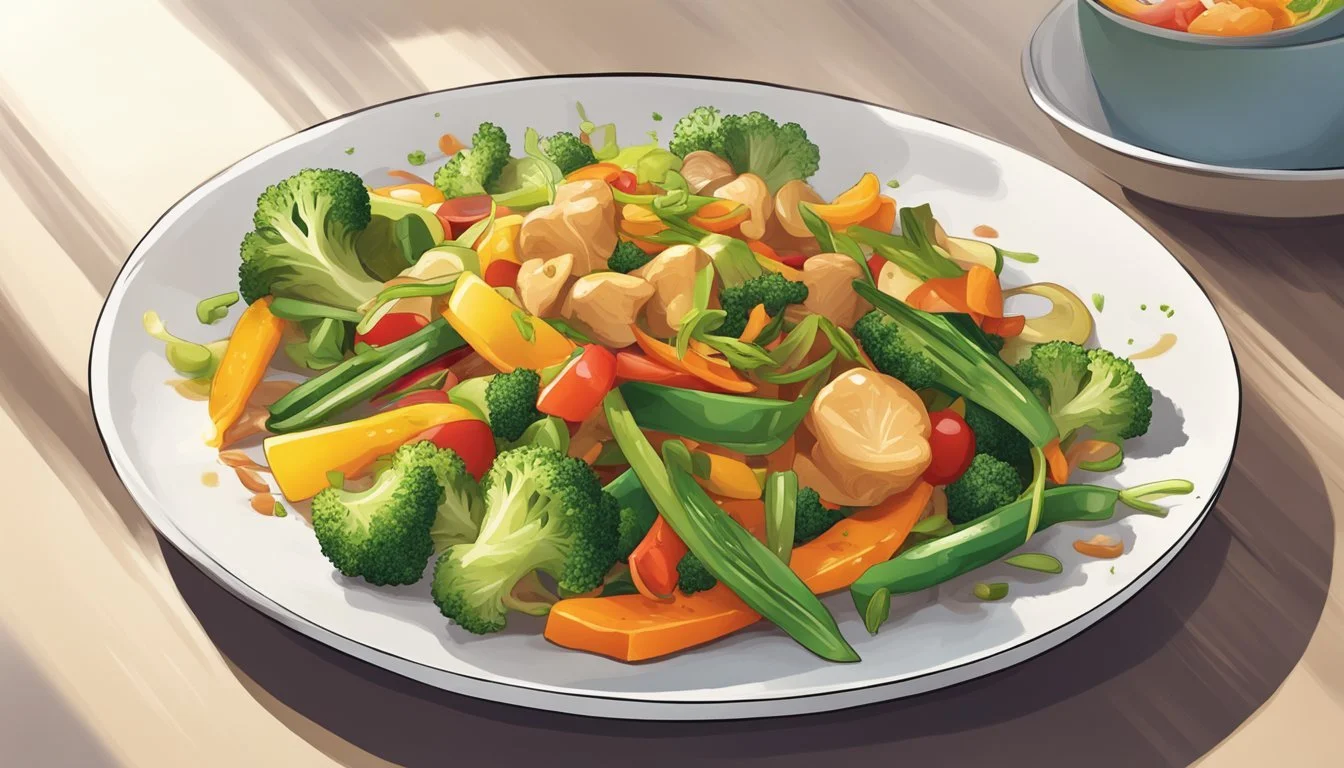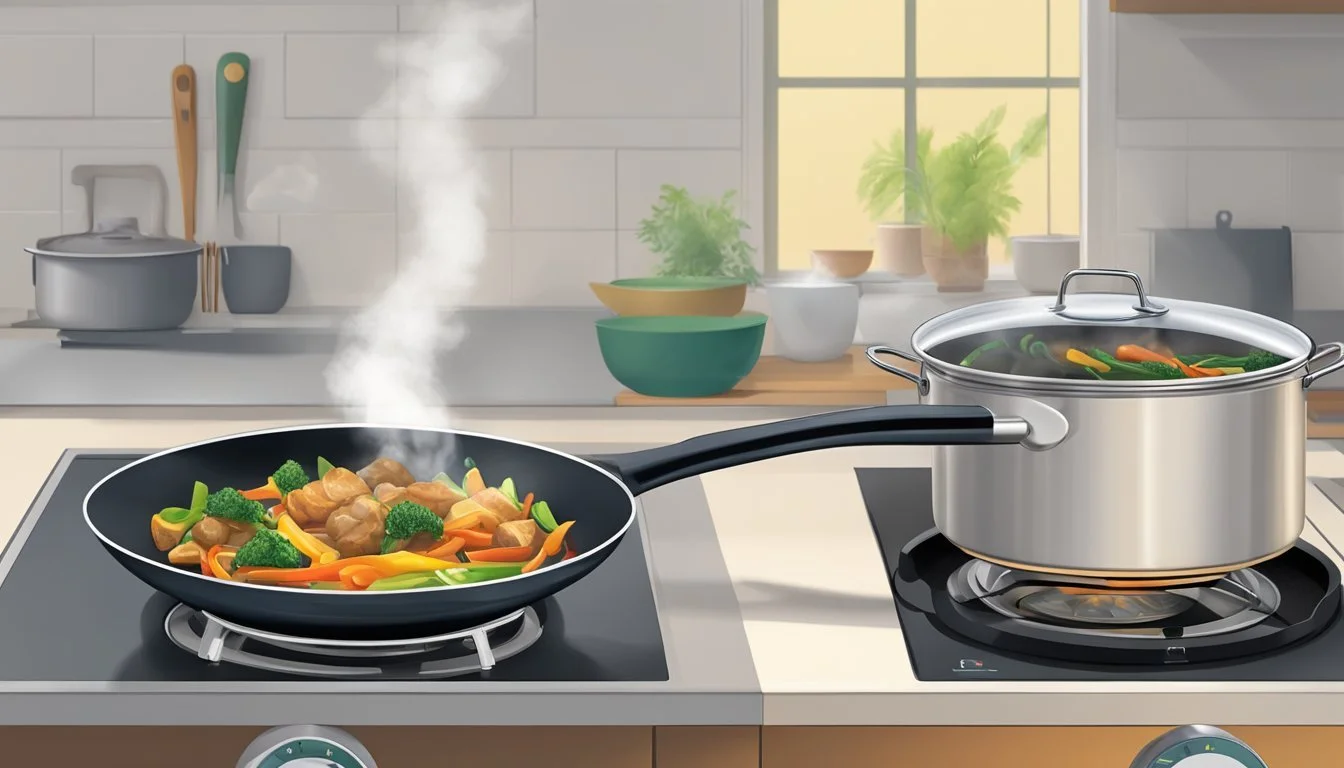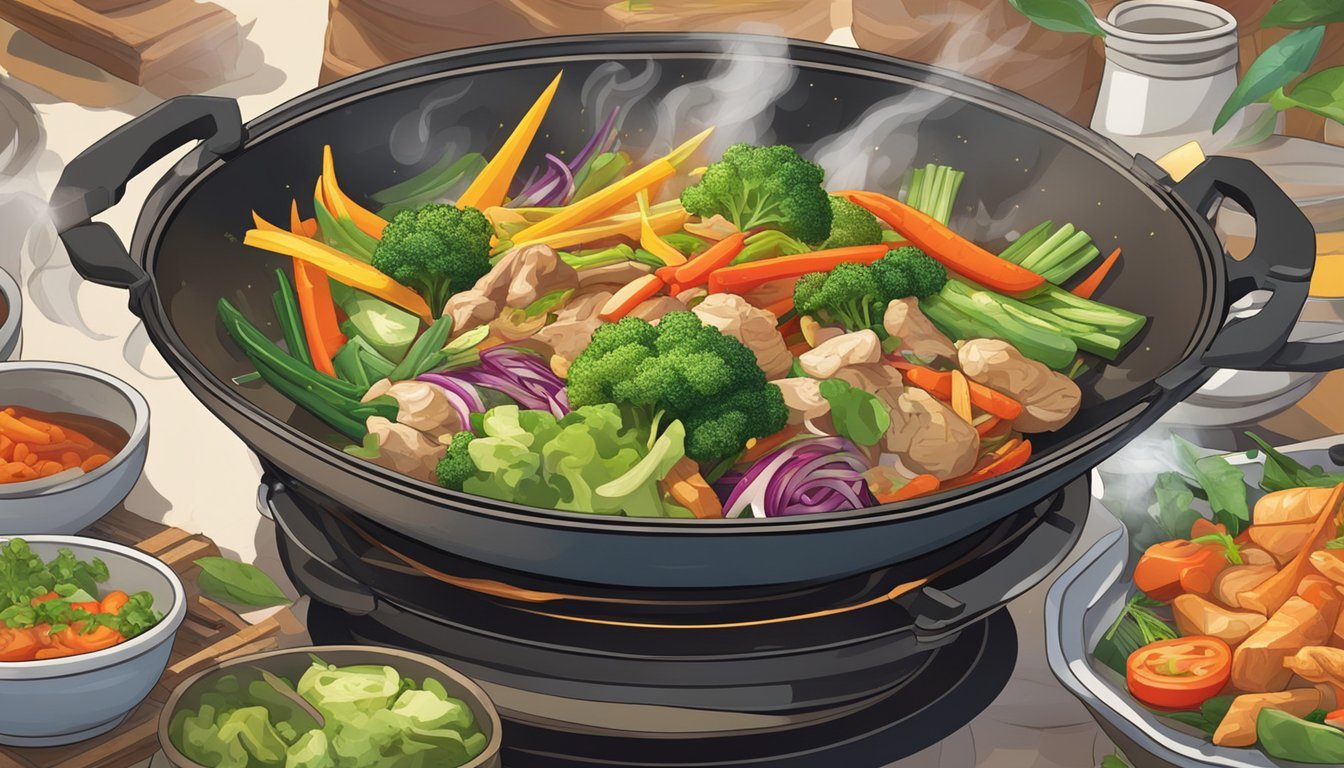How Long Do Freshly Prepared Stir-Fry Dishes Last?
Shelf Life Explained
Understanding the shelf life of a freshly prepared stir-fry is essential for both food safety and maintaining the quality of the dish. Stir-fries are popular for their quick cooking method and the vibrant mix of vegetables, proteins, and sauces, but once cooked, they are subject to the same food safety guidelines as any cooked meal. Typically, a homemade stir-fry will maintain its freshness for 3-4 days when stored in the refrigerator. The exact duration may vary based on factors such as the ingredients used, how the food is cooled, and the stability of the refrigerator's temperature.
Proper storage methods play a critical role in extending the life of a stir-fry. To maximize shelf life and safety, the stir-fry should be placed in an airtight container and refrigerated within two hours of preparation. Being prompt with refrigeration is crucial as leaving food at room temperature for too long can promote bacterial growth. Specialty ingredients in the stir-fry, such as seafood, may affect the storage time, with more perishable elements potentially shortening the safe window for consumption.
While keeping stir-fry in the refrigerator may preserve it for several days, the textural quality may decline as time passes. The crispness of vegetables and the tenderness of proteins can become compromised, which is why many people prefer to consume leftovers within a shorter timeframe to enjoy a meal that is closer to the quality of a freshly made dish. For those looking to maintain the dish's original flavor and texture, consuming it within the earlier part of its refrigerator lifespan is recommended.
Stir-Fry Basics
Preparing a stir-fry involves a synergy of ingredients, equipment, and techniques that, when executed correctly, result in a quick and flavorful dish. Key components include a variety of fresh ingredients and the use of high heat for cooking.
Key Ingredients
Vegetables: A mix of colorful vegetables, often including bell peppers, broccoli, carrots, and snap peas. They should be sliced uniformly for even cooking.
Meat or Protein: Common options are thinly sliced beef, chicken, shrimp, or tofu, allowing for quick and thorough cooking.
Aromatics: Ingredients such as ginger and garlic are essential for flavor foundation.
Oil: A high-smoking-point oil like canola or peanut oil is ideal for withstanding high cooking temperatures.
Soy Sauce: Adds a savory umami flavor, often used alongside other sauces for complexity.
Essential Equipment
Wok: The traditional choice due to its high walls and ability to distribute heat evenly. A wok allows ingredients to be moved around easily.
Frying Pan: If a wok is not available, a large frying pan can serve as a substitute, though it may not perform as well in tossing the ingredients.
Cooking Techniques
High Heat: Stir-frying is conducted over high heat to sear ingredients quickly, preserving their texture and nutrients.
Constant Motion: Ingredients are agitated consistently, using stirring and tossing motions, to ensure even cooking without burning.
Sequential Cooking: Ingredients are cooked in order of required cooking time, typically starting with proteins, then hard vegetables, and finally quick-cooking items like leafy greens.
Storing Fresh Stir-Fry
Proper storage techniques are crucial for maintaining the freshness and safety of stir-fry dishes. Utilizing the right methods for refrigeration and freezing ensures leftovers retain quality and remain safe to consume.
Refrigerator Storage
When storing stir-fry in the refrigerator, it should be placed in an airtight container to prevent moisture loss and contamination. Stir-fry lasts for 3-4 days in the fridge when stored promptly and at a consistent temperature. To maximize freshness, stir-fry should be refrigerated within two hours of cooking. It's essential to keep the refrigerator temperature at or below 40°F to hinder bacterial growth.
Plastic wrap or aluminum foil can also be used to cover dishes if airtight containers are not available, but this may not preserve the food as effectively.
Food should be divided into smaller portions to allow for quicker cooling and to minimize the time food spends in the temperature danger zone.
Moisture content of the stir-fry can affect storage life; for example, dishes with higher moisture may spoil quicker.
Freezing Instructions
Freezing stir-fry is an option for extending its shelf life beyond refrigeration limits. When freezing, stir-fry maintains quality for 1-2 months, provided it's stored correctly.
Before freezing, ensure the stir-fry is cooled to prevent moisture build-up and freezer burn. Use freezer bags or airtight freezer-safe containers to safeguard against freezer burn and flavor loss over time.
Label and date the containers to keep track of the storage duration.
Food safety is imperative when handling leftovers. Both refrigeration and freezing can slow down microbial growth, but they don't halt it entirely. One should always inspect the stir-fry for signs of spoilage before reheating and consuming.
Safety and Spoilage
When enjoying stir-fry dishes, one must balance the pleasure of leftovers with the risk of spoilage. Ensuring food safety and preventing food poisoning requires vigilance in recognizing signs of spoilage and understanding the limits of shelf life.
Recognizing Spoilage Signs
A freshly prepared stir-fry generally lasts 3-4 days in the refrigerator. To identify when stir-fry has gone bad, one should look for:
Odor: A sour or unusual smell is a clear indicator of spoilage.
Texture: If ingredients become slimy or the consistency has significantly changed, it is a sign of bacterial growth.
Mold: Visible mold in any part of the stir-fry indicates contamination.
Taste: If the flavor is off or unpleasant, it should be discarded immediately.
It's crucial to inspect leftovers before reheating, as consuming spoiled food can cause illness.
Food Poisoning Prevention
To minimize the risk of food poisoning, individuals should adhere to food safety guidelines:
Storage: Keep stir-fry in airtight containers in the refrigerator, away from the door to avoid temperature fluctuations.
Temperature: Ensure refrigeration below 40°F (4°C) to inhibit bacterial growth.
Hygiene: Always use clean utensils to prevent cross-contamination.
Following these practices will help maintain the quality of stir-fry leftovers and protect against foodborne bacteria.
Reheating Stir-Fry
Properly reheating stir-fry is essential to maintain its texture and flavor. The goal is to ensure that the leftover stir-fry is piping hot and as enjoyable as when it was freshly made.
Best Methods for Reheating
Stovetop (Wok or Skillet):
Preheat the vessel on medium-high heat.
Add the stir fry and reheat for 2-3 minutes, stirring occasionally.
Ensure it reaches a piping hot temperature throughout.
Microwave:
Place the stir-fry in a microwave-safe dish.
Cover with a microwave-safe lid or damp paper towel to retain moisture.
Heat on high for 1-2 minutes, stirring halfway through.
Oven:
Preheat the oven to 350°F (175°C).
Spread the stir-fry in an even layer in a baking dish.
Cover with foil and bake for 10-15 minutes.
Common Reheating Mistakes
Overcooking:
Causes texture changes; vegetables may become soggy and meats tough.
Best avoided by heating just until the stir-fry is hot enough to serve.
Reheating on too Low Heat:
Can result in uneven heating and reduced flavor.
Use high heat on the stovetop to reheat quickly and efficiently.
Not Stirring Frequently Enough:
May lead to some parts not heating thoroughly.
Keep the stir-fry moving to heat evenly.
Using the Wrong Method for the Amount:
Small portions may overcook in the oven; use the microwave or stovetop instead.
Large quantities may reheat unevenly in the microwave; the oven or stovetop is better for a consistent result.
Maximizing Freshness and Flavor
To ensure that stir-fry dishes maintain their peak flavor and freshness, one must consider both the cooking time and the use of natural preservatives. These factors play critical roles in preserving the texture, shape, and vibrant taste of the dish.
Optimal Cooking Time
Cooking time directly influences the texture and flavor of stir-fry ingredients. Vegetables should be stir-fried on high heat for a short amount of time to maintain their crunchy texture and bright color. For meats, one aims for a swift cook over high heat to sear in flavors while ensuring the inside is thoroughly cooked without becoming dry. Here is a quick guide:
Vegetables: 2-3 minutes on high heat, until they are brightly colored and still have a bite.
Meats: Depending on the type and cut, cook for 1-3 minutes until there are no pink parts visible.
Using Natural Preservatives
Natural preservatives can help in retaining the dish's freshness and extending its shelf life. Certain ingredients commonly used in stir-fry dishes, such as garlic, ginger, and chili, not only enhance flavor but also contain preservative properties. For example:
Garlic & Ginger: Add early into the oil for flavor infusion and their preservative effect.
Vinegar & Citrus Juice: A splash added at the end of cooking can brighten flavors and provide a preservative effect due to their acidity.
Incorporating these ingredients effectively can help in maintaining the dish's fresh taste and safe consumption for a longer period when stored properly.
Smart Storage Practices
Utilizing the right storage practices is pivotal for prolonging the freshness of stir-fry dishes and minimizing food waste. These practices ensure that stir-fry remains safe to consume and retains its flavor and texture for as long as possible when stored in the refrigerator.
Containers and Wrapping
Airtight Containers: For maximum longevity, one should place stir-fry in an airtight container before refrigeration. Airtight containers seal out moisture and air, which are prime culprits for spoilage and a decrease in food quality. Glass containers with secure lids are often recommended for their ability to maintain freshness and prevent the transfer of odors.
Wrapping: If airtight containers are not available, ensure that the stir-fry is wrapped tightly in cling film or aluminum foil. This wrapping acts as a barrier against contaminants and moisture, although it may not be as effective as a container with a sealed lid.
Food Placement Tips
Temperature: Always store stir-fry in the coldest part of the refrigerator, typically at the back, away from the door. This helps to maintain a consistent and proper cold temperature.
Height: Keep stir-fry at an appropriate height where it does not come into contact with raw foods, such as meats, which could lead to cross-contamination.
By adhering to these precise storage practices, the quality and safety of stir-fry in the refrigerator can be optimized.
Advanced Tips and Tricks
When it comes to maximizing the shelf life of a stir-fry and preserving its quality, certain techniques in storage and freezing can make all the difference.
Enhancing Shelf Life
Proper storage of stir-fry is critical for preserving its freshness. If stir-fry is to be consumed within a few days, ensuring it is cooled quickly to room temperature and then refrigerated within two hours of cooking is paramount. Store the stir-fry in airtight containers to prevent contamination and moisture loss. Refrigerated stir-fry can last for 3 to 4 days when properly stored.
Containers: Use shallow air-tight containers for even cooling and minimal exposure to air.
Temperature: Keep the refrigerator at or below 40°F (4°C).
Note: Separating different components (e.g. rice, vegetable stir-fry (What Wine Pairs Perfectly With Vegetable Stir-Fry?), meat) can help maintain texture and flavor when reheating.
Freeze Stir-Fry without Losing Quality
Freezing can extend a stir-fry's shelf life significantly. When freezing stir-fry, it is crucial to use freezer-safe containers or bags that are sealed well to prevent freezer burn. Ensure that the stir-fry has cooled completely before packaging it to avoid ice crystal formation. The ideal freezing temperature is 0°F (-18°C) or lower.
Freezing Process:
Portion: Divide the stir-fry into meal-sized portions for convenience.
Wrap: If using bags, remove as much air as possible before sealing.
Label: Mark the date on the container or bag to keep track of freshness.
For meat and vegetables, consider blanching vegetables or partially cooking the meat before freezing to maintain quality. Stir-fry can be stored in the freezer for up to 3 months.
Thawing: Always thaw frozen stir-fry in the refrigerator or use the microwave for a quicker option.
Following these tips and tricks ensures that stir-fry remains as fresh and flavorful as possible, whether it's served the next day or pulled from the depths of the freezer after several weeks.
Recognizing Quality in Takeout
When it comes to takeout, particularly stir-fry dishes, the quality is paramount both for taste and food safety. Diners should not only enjoy the flavors but also feel confident about the freshness and handling of their meals.
Analyzing Freshness of Received Meals
Upon receiving a stir-fry takeout order, immediately assess the texture and color of the ingredients. Fresh vegetables should be vibrant, crisp, and free from unpleasant odors, indicating they have retained their nutritional value and flavor. The meats should be properly cooked through and tender. Any signs of discoloration, off-odors, or an unusual amount of liquid at the bottom of the container may signal that the food is no longer fresh.
Common areas to inspect for freshness include:
Vegetables: Look for brightly colored vegetables with no wilted leaves or slimy surfaces.
Meat: Ensure there's no grayish tint and that any marinade or sauce hasn't separated, implying staleness.
Rice or Noodles: Check if they are neither too dry and splitting nor excessively sticky, which can suggest overholding.
Safe Handling of Leftovers
Managing leftovers starts with proper storage. Stir-fry should be refrigerated within two hours of delivery to prevent bacterial growth. Divide large quantities into shallow containers to cool them more rapidly and effectively. When reheating, one should aim to reach an internal temperature of 165°F to ensure food safety. Consume leftovers within three to four days to minimize the risk of foodborne illnesses.
Key practices include:
Temperature: Store leftovers below 40°F.
Reheating: Use a microwave, oven, or stovetop to uniformly heat the food all the way through.
Portioning: Split into smaller quantities for efficient cooling and reheating.
Avoid common mistakes, such as leaving the food out too long or reheating multiple times, which can compromise both the quality and safety of the stir-fry.
Troubleshooting Common Stir-Fry Problems
When cooking stir-fry, two frequent issues chefs encounter are soggy vegetables and overcrowded pans which can lead to uneven cooking. Identifying and rectifying these problems is crucial for achieving the perfect stir-fry texture.
Fixing Soggy Vegetables
To prevent vegetables from becoming soggy in a stir-fry, one should ensure they are thoroughly dried after washing. A salad spinner or kitchen towels can be used to remove excess moisture. Here is a simple guide to avoid sogginess:
Broccoli and Carrots: These hardier vegetables should be blanched briefly in boiling water and then shocked in ice water before stir-frying.
Zucchini: Due to its high-water content, cook zucchini in smaller batches and for a shorter duration to maintain texture.
Vegetables should also be added in the correct order. Start with those that take longer to cook, like carrots, and end with quicker-cooking vegetables like zucchini.
Eliminating Overcrowding Issues
Overcrowding the pan can cause vegetables and meats to steam rather than fry, resulting in a less desirable texture. To avoid this:
Batch Cooking: Cook ingredients in batches, especially if working with a smaller pan.
Heat Management: Keep the heat high and consistent. If the pan cools too quickly when ingredients are added, increase the heat accordingly.
Pan Size: Use a large wok or skillet to give ingredients plenty of space to cook.
A small amount of stock can be used if the stir-fry becomes too dry. However, adding too much liquid contributes to overcrowding and can cause vegetables to braise rather than fry, leading to sogginess.
Exploring Stir-Fry Variations
Stir-fry dishes are a mosaic of flavors and textures, with the variation in protein and vegetables creating an array of options for every palate.
Protein Choices
In the realm of stir-fry proteins, choices abound. Traditional chicken stir-fry is a staple, with thinly sliced chicken breast or thigh often used for their quick cooking times and ability to absorb savory soy sauce and other marinades. Not limited to poultry, stir-fry can be customized with a range of proteins including:
Beef: Best sliced thin against the grain for tenderness
Pork: Cut into small pieces for expedient cooking
Shrimp: Cooking quickly, making them ideal for a speedy stir-fry
Tofu: A popular plant-based option that adds a hearty texture
One should ensure that the protein choice is cooked through before combining with vegetables, generally requiring a brief cook time over high heat with a suitable oil that has a high smoke point.
Vegetable Combinations
The selection of vegetables in a vegetable stir-fry can vary widely based on preference and seasonal availability. A typical combination might include:
Firm vegetables: Broccoli, carrots, and bell peppers, sautéed to soften
Leafy greens: Spinach or bok choy, added towards the end of cooking
Aromatics: Garlic, ginger, and onions, used to infuse the oil with flavor
Ensuring a medley of textures and colors not only enhances the visual appeal but also ensures a well-rounded nutritional profile. Vegetables should be cooked until they are tender-crisp, maintaining a slight crunch. The cooking sequence often starts with the hardest vegetables which take longer to cook, followed by softer ones that require less time.











